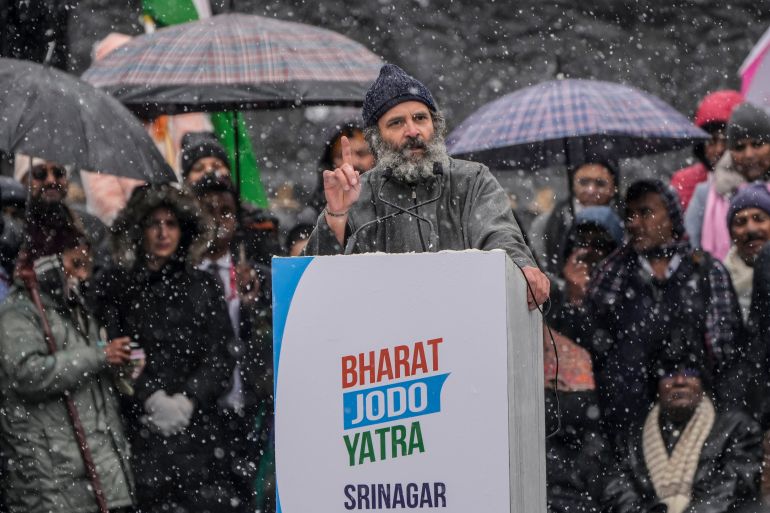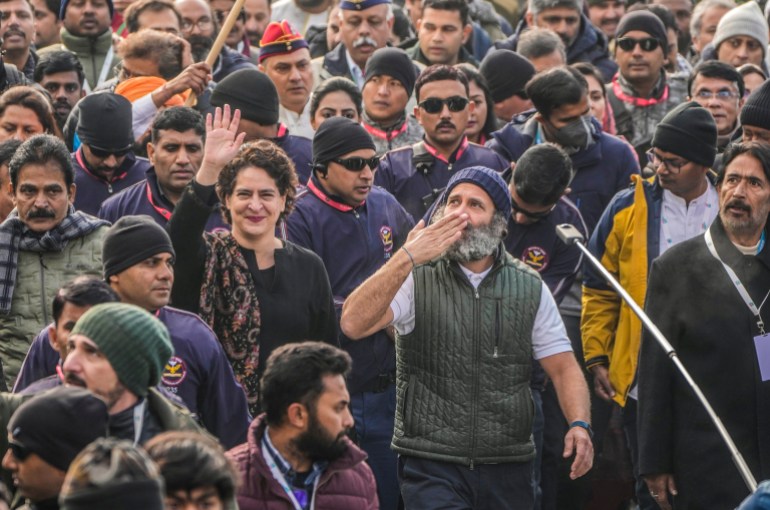Gandhi’s 150-day march is over. But will it revive Congress?
Leader of India’s main opposition party concludes cross-country ‘unity’ march in Kashmir, five months after departing from Tamil Nadu state.

New Delhi, India – Hundreds of people on Monday defied the harsh Himalayan cold as they gathered in Srinagar, the largest city in Indian-administered Kashmir, to join opposition leader Rahul Gandhi on the last day of his nearly 150-day cross-country “unity” march.
Launched on September 7, 2022 from the country’s southernmost tip of Kanyakumari in Tamil Nadu state, the Bharat Jodo Yatra or Unite India March traversed through 14 states covering more than 70 districts.
Keep reading
list of 4 itemsHaiti Prime Minister Ariel Henry resigns, transitional council takes power
Spain prosecutor seeks dismissal of corruption case against Sanchez’s wife
Students vow to continue Gaza protests after California, Texas arrests
It saw a large number of people – from prominent civil society members and activists to local leaders and celebrities – trying to keep up pace with the 52-year-old scion of India’s most famous political family throughout his journey spanning a distance of nearly 3,500km (2,175 miles).
Political observers described the march as a last-gasp attempt by Gandhi to revitalise the fortunes of his beleaguered Congress Party ahead of national elections due next year.
But for his supporters, the march was an audacious attempt to bridge the nation’s political and religious divisions, which they blame on the policies of the Hindu nationalist government of the Bharatiya Janata Party (BJP), led by Prime Minister Narendra Modi.
“This is a march to unite the people of the country against the bigotry and hatred,” said 48-year-old Uzma Sakib, who flew more than 2,000km (1,243 miles) from the southern state of Telangana to join the march in her native state of Kashmir.
“He [Gandhi] has resurrected as a person and a leader who can feel the pain and empathise with the aam aadmi [common man]. And this is the kind of leader that our nation needs,” Sakib told Al Jazeera from the Kashmir valley.
“He is our only hope.”
Reviving hopes of a ‘comeback’
The Congress Party has governed India for a total of nearly 60 years since independence in 1947, but its influence has sharply waned since losing national elections to the BJP in 2014, followed by a slew of defeats in state and local elections in the years that followed.
It currently holds a clear majority in only three of India’s 31 states and union territories, with analysts pointing to the party’s lack of a clear-cut ideological framework and its inability to let go of the Gandhi family’s influence for its poor election showings.
According to the National Election Watch and the Association for Democratic Reforms, a total of 399 electoral candidates quit Congress to join other parties between 2014 and 2021. During that period, the party lost 39 out of 49 state elections.
And while many prominent Congress leaders have faced public discontent over the years, it has been under the de facto leadership of Rahul Gandhi – often portrayed as an incompetent and reluctant politician by a section of the Indian media – that the party’s electoral gains touched historic lows in the 2014 and 2019 general elections, winning just 44 and 52 seats, out of 543, respectively.
Now, some observers say the march is the first step – albeit a very small one – in the right direction to pull Congress and its scion out of the political wilderness.
“It is not an easy process. It takes years for leaders to emerge as national leaders,” said Rasheed Kidwai, a veteran journalist and political analyst, who has been covering the Congress Party for decades. “Despite that, what he [Rahul Gandhi] has managed to do through this yatra is unconventional.”
However, Kidwai was quick to caution that the march may not be enough.
“At the end of the day, it’s the vote that matters – and that’s where the yatra has insurmountable challenges,” he said, noting that the BJP managed to increase its vote percentage from 31 percent in 2014 to 38 percent five years later.
“The job of a political party is to win elections. That is the barometer on which a party is assessed. How this yatra would prove for the electoral gains of the party needs to be seen,” he added.
Neither Congress leaders nor supporters, though, claim the march is specifically aimed at improving the party’s election results. Instead, Congress asserts the march seeks to address “rampant unemployment and inflation, the politics of hate and division and the over-centralisation of the political system” in the country.
“It is a fight against the attitude of hatred which prevails in our country and not a debate about who would win or lose,” Salman Khurshid, a senior Congress leader, told Al Jazeera.
Khurshid acknowledged the party must step up efforts to spread its message but expressed confidence that the march had led to a change in the way the public viewed both Congress and Gandhi. “My political instinct says that people have started looking up to Rahul as someone who has the ability to draw the attention of people, not just in pockets, but right across the country,” he said.
Just another ‘rebranding’ effort
But for the BJP, the march was just another failed attempt at rebranding the image of Gandhi.
“The purpose of this yatra is not to unify the opposition, as it’s been claimed,” Gopal Krishna Agarwal, the national spokesperson of the BJP, told Al Jazeera.
“The Congress Party is only trying to relaunch Rahul Gandhi and this effort has been going on for quite some time now,” he said.
A study this month found that only 13 percent of respondents considered the march as yet another “re-branding” exercise for Gandhi, while 29 percent firmly believed it was a success in uniting the masses.

However, 37 percent still believed the march would not translate into votes for Congress, according to the CVoter survey, conducted by the country’s media conglomerate India Today group.
Back in Srinagar, 32-year-old Ishita Sedha, a staunch Congress loyalist, was preparing to return to her hometown in Uttarakhand at the culmination of the 150-day-long journey.
“For me, it has been a spiritual journey,” Sedha told Al Jazeera, describing the march as “life-changing”.
“Now I can proudly say that I have done something for my nation. And this whole march has really been a learning ground for me, which I aspire to continue on my individual level,” she said.